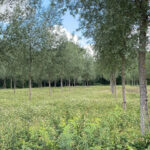Cricket Bat Willow Planted In Crewe
The existing woodland on the Crewe Estate in Cheshire included approximately 15 acres of poplar stands which had become over-mature and which, in line with the Duchy’s woodland management plan, were felled last year.
Over the next few years, the Duchy plans to restock these sites with English cricket bat willow (Salix Alba Caerulea), working in partnership with leading willow growers J S Wrights. This is a family business established in 1894 who are the market leaders in the production of cricket bat willow; around 75 per cent of the world’s cricket bats are made from Wrights’ willow.
Salix Alba Caerulea is a species which thrives in wet conditions and takes around 20 years to fully mature. It is fast-growing and produces timber which is uniquely suited to cricket bat manufacture, as it is light-weight and, although categorised as a hardwood species, also has some of the properties of softwood. The sites will also undergo coppicing at the edges and some interspersed broadleaf trees at the boundaries to improve the biodiversity of the woodland.
Commenting on the restructuring of the Crewe woodland, Estate Director Laura Airton said: “We are very keen to invest in our woodland and ensure that it is both sustainable and appropriate to the local landscapes on our estates. These new trees will lock-up carbon each year as they grow and the captured carbon will be retained in the end product.”
The planting of indigenous species of trees is a key part of the Duchy’s five-year woodland management strategy and the first phase of planting circa 200 trees across five acres in Cheshire is already underway. Last year, we completed the first phase of a habitat plan which will create 25 acres of new woodland in Staffordshire and are in ongoing discussions with the Forestry Commission, Natural England and local Area of Outstanding Natural Beauty teams to design a new 50-acre wood on the Whitewell Estate in Lancashire.


